Spanning a vast 83,570 square miles, Idaho is one of the larger states in the U.S. It has diverse habitats from snow-capped mountains to numerous river basins. Snake River is one of the most important rivers in Idaho, and it runs through Hells Canyon, the deepest gorge in the entire United States. With such a variety of habitats, it’s no surprise that Idaho also has an incredibly diverse range of animals that call it home, from tiny insects to the massive moose. So, join us as we learn about some of the largest animals in Idaho and discover where you’ll find them!

1. Sandhill Crane
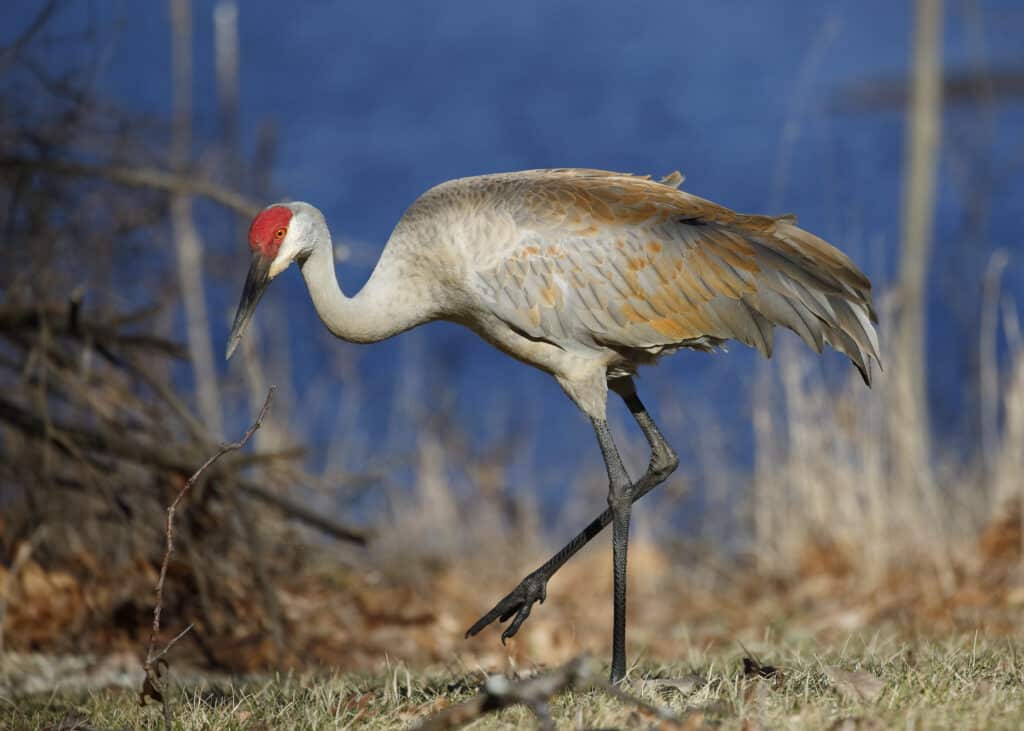
The sandhill crane lives in freshwater wetland areas such as swamps and river basins.
©Brian Lasenby/Shutterstock.com
Idaho is a common stopping point for sandhill cranes on their migratory route, and thousands of these birds can be seen in the state during the fall and winter months, with Grays Lake Wildlife Refuge being one of the best spots. The sandhill crane is a large grey bird with a red crown on its head. It has a wingspan of 5 feet 5 inches to 7 feet 7 inches and can stand up to 4 feet 6 inches tall. Sandhill cranes live in freshwater wetland areas such as swamps and river basins. They are herbivores and eat various seeds, corn, fish, snails, amphibians, and reptiles. Sandhill cranes are social animals and live in pairs or family groups all year round, although when they are migrating, they come together to form huge flocks.
2. Channel Catfish
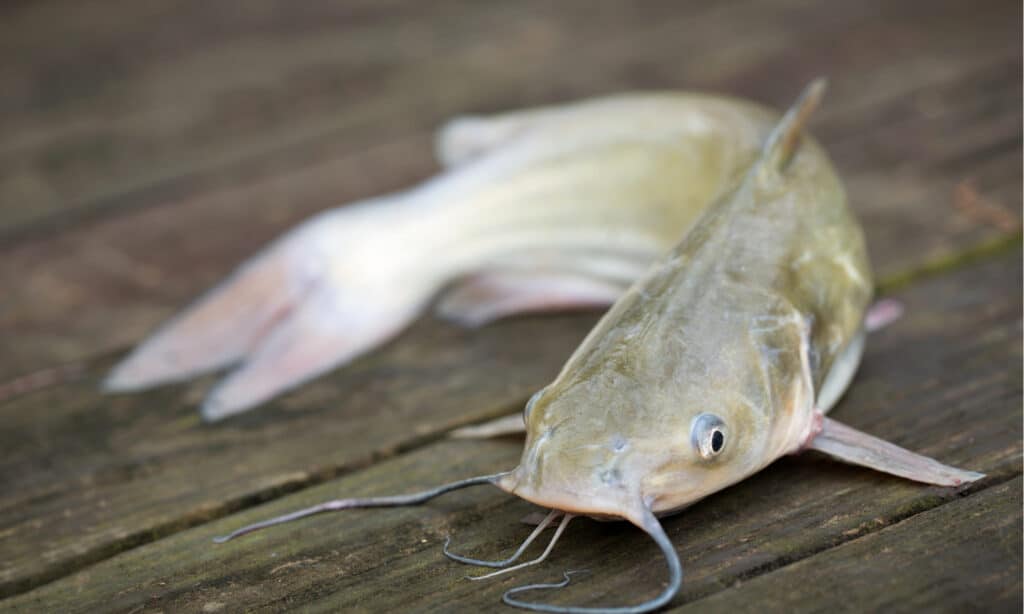
Channel catfish can reach 52 inches long and weigh up to 58 pounds, making them highly popular with anglers.
©Jennifer White Maxwell/Shutterstock.com
Although not native to the state, channel catfish are now commonly found in the state after being introduced to its rivers and lakes, with Snake River being one of the best spots to find them. Channel catfish are large freshwater fish that have four distinctive barbels on their face. They can reach 52 inches long and weigh up to 58 pounds, making them highly popular with anglers. Channel catfish are predatory fish and prey on a wide range of other fish species as well as birds, small mammals, snakes, frogs, insects, snails, and crustaceans.
3. Western Rattlesnake

The western rattlesnake is the longest snake in Idaho and can reach 4 to 6 feet long.
©Tom Reichner/Shutterstock.com
Twelve species of snakes are native to Idaho, and only two are venomous. The western rattlesnake is the longest, reaching 4 to 6 feet long. Western rattlesnakes are typically yellowish brown, dark brown, or grey with lark dark blotches across their body. They live in various habitats, but in Idaho, they prefer grasslands and dry, rocky areas. They can be found everywhere in the state except in the northernmost regions and high elevations. Western rattlesnakes prey on small mammals, reptiles, amphibians, and birds.
4. Achemon Sphinx Moth

The Achemon sphinx moth, which has a wingspan of about 3.5 inches, lives in woodlands and gardens.
©Sassafras56/Shutterstock.com
One of the largest insects in Idaho is the achemon sphinx moth which has a wingspan of approximately 3.5 inches. Achemon sphinx moths have pinkish-brown forewings with a square-shaped spot and pink hindwings with brown markings. These stunning moths live in woodlands and gardens. They mainly feed on nectar from flowers (particularly Japanese honeysuckle) and the leaves from grapevines. They are often classed as pests in vineyards.
5. Grizzly Bear

It is important to stand tall, act intimidating, and never run away if a bear is approaching you.
©Perpis/Shutterstock.com
With the largest males weighing up to 790 pounds, it’s not surprising that grizzly bears have a somewhat fearsome reputation. Grizzly bears are a North American subspecies of brown bears and live in forests, woodlands, and prairies. They hibernate in dens during the winter for as long as 5 to 7 months. They are omnivores and eat a wide range of fruit, nuts, fish, and mammals. Grizzly bears are strong hunters capable of preying on large animals such as moose, elk, and bighorn sheep. Grizzly bears were once widespread across Idaho but are now only found in the northern and eastern parts of the state.
6. Gopher Snake
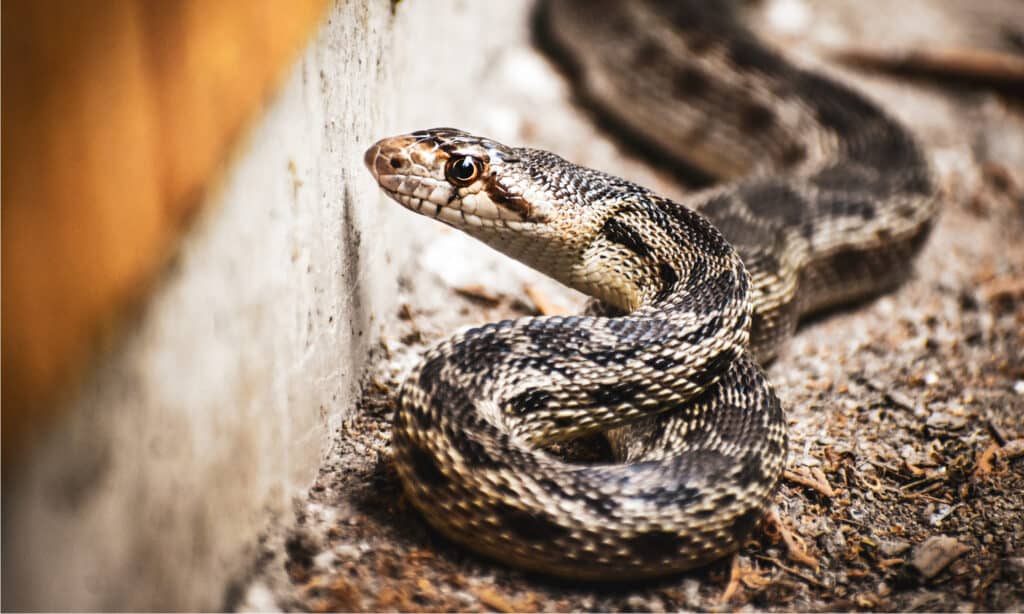
Gopher snakes are not venomous but are often mistaken for the similar-looking prairie rattlesnake.
©Cedar Dobson/Shutterstock.com
One of the largest animals in Idaho is undoubtedly the gopher snake, which can attain lengths of up to 9 feet. Gopher snakes are usually a pale yellow-brown color overlaid with dark brown blotches and spots. They are not venomous but are often mistaken for the similar prairie rattlesnake. They also sometimes act similarly by puffing themselves up and rearing off the ground while vibrating their tail. However, they tend to give “warning bites” first, delivered with their mouth closed. Gopher snakes are constrictors and feed on various rodents, birds, and gophers. They are endemic to North America, where they live in a wide variety of habitats. They can be found in most parts of Idaho, except the state’s northern region.
7. Bald Eagle

Bald eagles are well known for building the largest nests of any bird in the world.
©PHOTOOBJECT/Shutterstock.com
The largest bird in Idaho is the bald eagle, with a massive wingspan of 5 feet 11 inches and 7 feet 7 inches. These huge birds are best known as the United States national bird and are easily distinguished by their dark brown plumage and bright white heads and tails. Bald eagles are also well known for building the largest nests of any bird in the world, and the largest nests can be up to 9 feet wide and 20 feet deep. Bald eagles are sea eagles and typically live near large bodies of water, particularly around coastlines and large lakes, where they predominantly feed on fish. Although some bald eagles remain in Idaho all year round, they are most often seen in the state during the winter, especially at Lake Coeur d’Alene, Lake Pend Oreille, and near the Boise River.
8. White Sturgeon
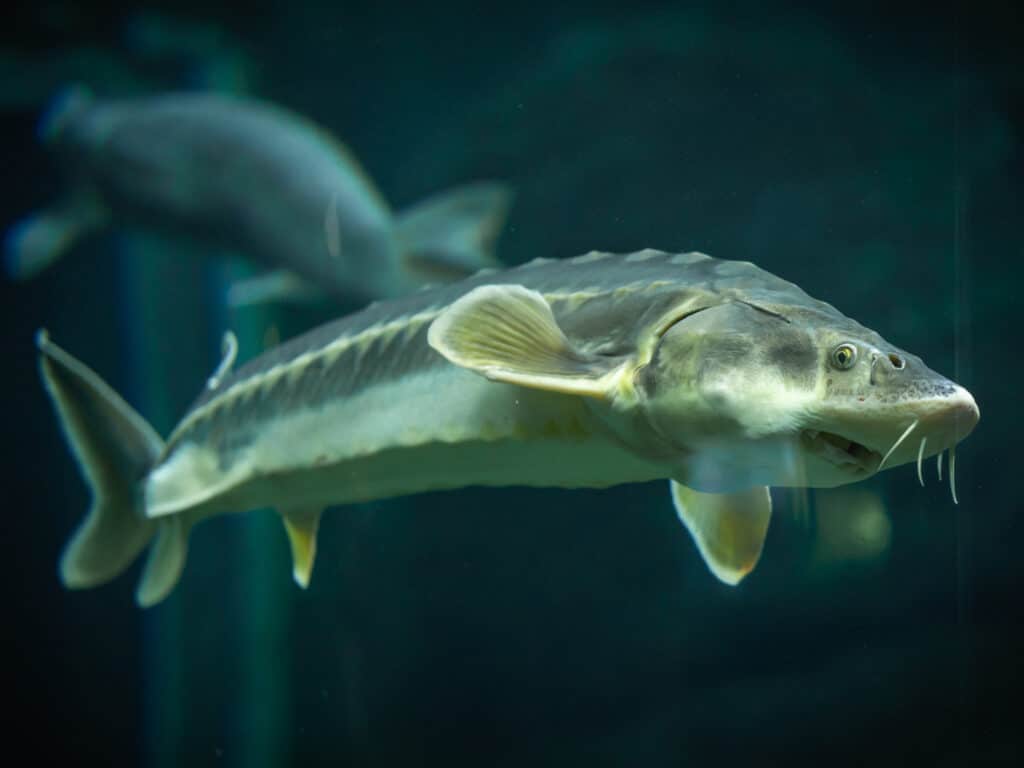
White sturgeon are native to North America and live in rivers leading out to the Pacific Ocean.
©DIGITALSHAPE/Shutterstock.com
Lengths of 20 feet and weights of up to 1,800 pounds easily put the white sturgeon on the list of the largest animals in Idaho. These massive fish are typically grey or brown and have rows of distinctive bony plates on their bodies. White sturgeon are native to North America and live in rivers leading out to the Pacific Ocean. In Idaho, they typically live in the Snake River, where a catch and release system is in place due to their status as a vulnerable species. White sturgeon are bottom feeders with an opportunistic nature, and they mainly feed on fish and eat crustaceans, clams, and mollusks.
9. California Root Borer

The California root borer typically lives underground, where its larvae feed on the roots of shrubs and deciduous trees.
©mikeledray/Shutterstock.com
The largest beetle in Idaho is the California root borer, which is between 1 and 2.2 inches long. California root borers are reddish-brown, and as a species of longhorn beetle, they are characterized by their long antennae. They typically live underground, where their larvae feed on the roots of shrubs and deciduous trees. The larvae gradually move upwards through the root system and can eventually seriously damage the trees, often leading to them achieving pest status. Adults do not feed at all and have a short lifespan of only 10 to 20 days.
10. Moose
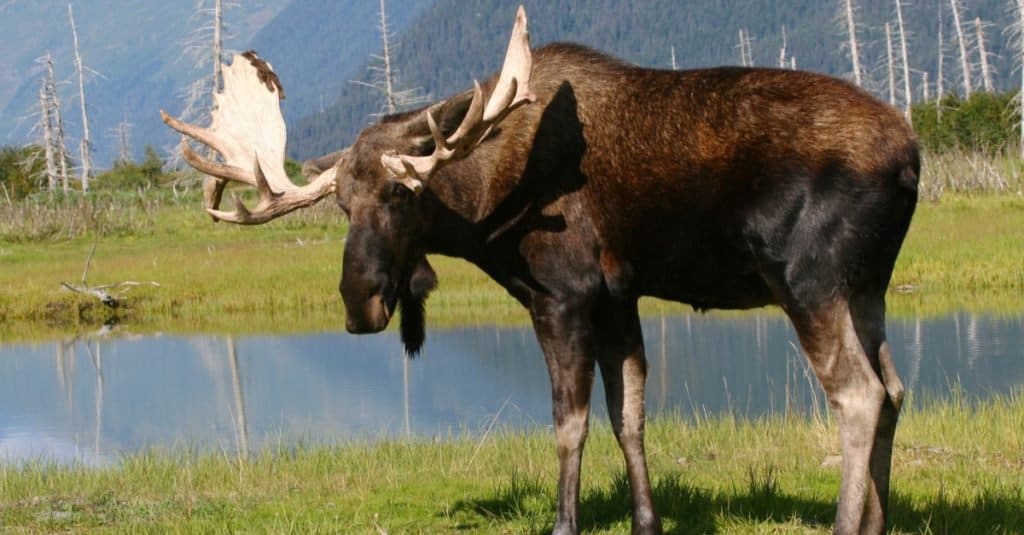
Moose are powerful swimmers. A moose can dive 20 feet underwater and stay underwater for up to 30 seconds!
©Steve Bower/Shutterstock.com
The largest animal in Idaho is the massive moose, which can weigh up to 2,300 pounds. Moose are the largest members of the deer family, and standing between 4 feet 7 inches and 6 feet 11 inches high at the shoulder, they certainly cut an imposing sight. However, none are more impressive than the males, who also have an impressive set of broad-shaped antlers. Moose are herbivorous animals and typically live in forest regions with plenty of vegetation for them to eat. However, they are also incredibly good swimmers and are uniquely adapted to be able to eat while underwater. Moose can manage this because they have large, fatty pads over their nostrils, allowing them to close them while underwater. Moose are found everywhere in Idaho, except for the state’s southwestern region and near Boise.
Summary of the 10 Largest Animals in Idaho, and Where You’ll Find Them
Here’s a recap of the top 10 biggest animals found in Idaho that we took a look at.
| Number | Animal | Size | Range in Idaho |
|---|---|---|---|
| 1 | Sandhill Crane | Wingspan: 5 feet 5 inches to 7 feet 7 inches; Height: up to 4 feet 6 inches | Idaho is a common stopping point on their migratory route. |
| 2 | Channel Catfish | Length: can reach 52 inches; Weight: up to 58 pounds | Commonly found in the state after being introduced to its rivers and lakes, with Snake River being one of the best spots |
| 3 | Western Rattlesnake | 4-6 feet long | Everywhere in the state except northernmost regions and high elevations |
| 4 | Achemon Sphinx Moth | Wingspan: 3.5 inches | Woodlands and gardens |
| 5 | Grizzly Bear | Weigh up to 790 pounds | Once widespread across Idaho, now only found in the northern and eastern parts |
| 6 | Gopher Snake | Length: up to 9 feet | Most parts of Idaho, except the state’s northern region |
| 7 | Bald Eagle | Wingspan: 5 feet 11 inches to 7 feet 7 inches | Some remain in Idaho all year round; most often seen during the winter, especially at Lake Coeur d’Alene, Lake Pend Oreille, and near the Boise River |
| 8 | White Sturgeon | Length: 20 feet; Weight: up to 1,800 pounds | Typically live in the Snake River, where a catch and release system is in place |
| 9 | California Root Borer | 1-2.2 inches long | Underground, where larvae feed on roots of shrubs and deciduous trees |
| 10 | Moose | Weight: up to 2,300 pounds; Height: 4 feet 7 inches to 6 feet 11 inches | Found everywhere in Idaho, except for the southwestern region and near Boise |
The photo featured at the top of this post is © Perpis/Shutterstock.com
Sources
- Moth Identification, Available here: https://www.mothidentification.com/achemon-sphinx-moth.htm
- Visit Idaho, Available here: https://visitidaho.org/travel-tips/idahos-top-eagle-watching-spots
- Idaho Official Government Website, Available here: https://idfg.idaho.gov/conservation/grizzly-bears
Thank you for reading! Have some feedback for us? Contact the AZ Animals editorial team.






